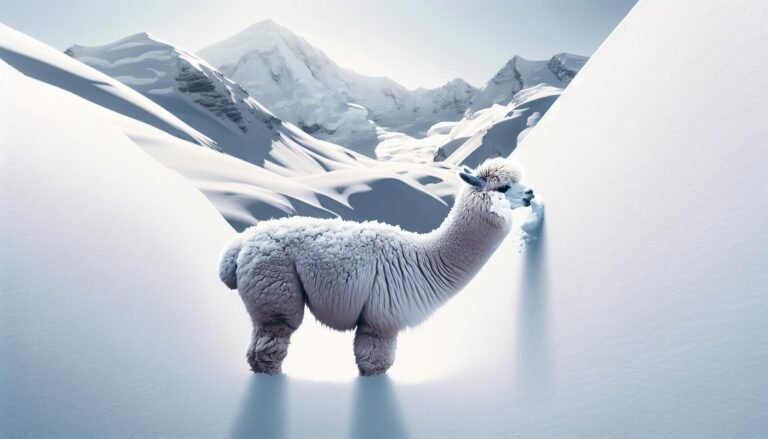Fascinating Aspects of Alpaca Sleep Patterns
Ever watched an alpaca snooze? If you haven’t, you’re in for a treat. Alpacas have a unique and fascinating sleep cycle that’s different from many other animals. It’s not just about catching some Z’s for these fuzzy creatures; their sleep patterns are a survival tactic honed by evolution.
In the wild, alpacas need to be constantly alert for predators. That’s why they’ve developed the ability to sleep while partially awake. Sounds intriguing, doesn’t it? Well, there’s more to this story. Stick around as I delve deeper into the captivating world of alpaca sleep.
Alpaca Sleep Patterns
One marvel of the animal kingdom, is the alpaca sleep pattern. Taught by nature’s classroom, alpacas have become adept at catching sleep in potentially risky environments. There’s more to it than what meets the eye though. Alpacas don’t just snooze standing up. They’ve developed a unique method of resting that elevates their survival game to a whole new level.
We typically see only two types of sleep: REM (rapid eye movement) and NREM (non-rapid eye movement). The most restorative sleep happens during REM. This normally occurs laying down for humans. But, alpacas mix it up and have some variations in their sleeping patterns.
In the alpaca world, some REM sleep does occur standing up. You’ll notice this when observing an alpaca that seems like it’s zoning out while still standing on its feet. The other type of sleep, NREM, happens with the alpaca laying flat on its stomach. This position enables them to jump up quickly if a predator strikes. This dual sleep mode gives them an edge, allowing them to stay semi-conscious and vigilant even while catching some Z’s.
There’s an interesting difference in duration as well. My observation pointed out some surprising differences when compared to human sleep cycles. Here’s a quick look at how their sleep cycle compares to ours in a typical 24 hours.
| Species | Sleep hours |
|---|---|
| Human | 7-9 |
| Alpaca | 4-5 |
Alpacas manage on significantly less sleep than we do. This difference, shines some light on the hardy nature of these creatures. How they’ve evolved to be alert for long periods, increasing their survival odds in animal kingdom. We’re barely scratching the surface here. Stick around as we explore this captivating world of alpaca sleep. Dive further into their REM and NREM sleep cycles in the next section.
Understanding the Evolutionary Background
Venturing back to alpaca’s wild ancestors, it’s noteworthy that these humble creatures hail from a lineage of wild camelids. These species lived in tough conditions and evolved over thousands of years to develop survival strategies, including adapted sleep habits, which we now see in our present-day alpacas.
Diving deeper into these sleeping patterns, they’re unique yet highly effective. The two-tier sleep cycle, including REM and NREM, is an apparent outcome of their ancestor’s survival mechanisms. This pragmatic adaptation lets alpacas gain the rest they need while maintaining a steady state of awareness.
Looking at humans, we usually have a distinct REM stage where we are virtually rendered immobilized and oblivious to our environment. On the contrary, alpacas have a modified REM stage. Some of their REM sleep occurs while standing up, giving them the advantage of being able to wake up and make a swift escape if required.
Additionally, alpacas have honed the practice of lying flat for their NREM sleep. This posture keeps their profile low against the terrain, making it difficult for predators to spot them. Interestingly, NREM sleep makes up a larger share of their sleep cycle—typically 75-80%. Let me represent this data for a clearer comparison:
| Alpacas | Humans | |
|---|---|---|
| REM Sleep (%) | 20-25 | 20-25 |
| NREM Sleep (%) | 75-80 | 75-80 |
From this table, it’s clear that while the percentage breakdown between REM and NREM sleep is similar in alpacas and humans, the function and arrangement of these stages vary significantly.
By comprehending the evolutionary background of alpacas, I’ve shed light on how their two-tier sleep cycle mirrors the survival tactics acquired over evolution. Moving forward, we’ll delve into more fascinating details about REM and NREM sleep in alpacas, and how these strategies play a crucial role in their daily life.
The Unique Ability to Sleep while Partially Awake
Examining closely, alpacas have a unique ability to sleep while partially awake, an adaptation that has perplexed scientists for years. It’s not so much that they’re half-asleep, but their bodies have retained the internal command center to remain on high alert even during sleep. Let’s delve a bit deeper into how this miraculous ability works.
During the REM stage of sleep, the part of the alpaca’s brain that controls movement is practically shut down. Yet, this is when they’re most likely found standing up. One might wonder how they manage to stay upright. Well, it’s because alpacas have a modified REM stage where their large muscle groups, especially those in their limbs, remain active to keep them standing. This tweak enables alpacas to achieve both restful REM sleep whilst staying prepared for any imminent threats.
When it comes to NREM sleep, our furry friends lie flat on their stomachs. This state is often mistaken for an illness by inexperienced caretakers. But rest assured, it’s just an alpaca’s version of deep sleep! During this phase, they’re often hardest to stir. But thanks to their evolved survival instinct, their brain remains vigilant while their body rejuvenates.
The layout of alpaca’s two-tier sleep system is listed below to help you understand better.
| Sleep Stage | Position | Percentage of Total Sleep |
|---|---|---|
| REM | Standing up | 20-25% |
| NREM | Lying flat | 75-80% |
These intriguing aspects of alpaca sleep behavior underline not only the adaptive nature of these resilient animals but also the sleep’s importance for their health and well-being. There’s still a lot that remains unknown about alpaca sleep, thus fuelling the keen interest of scientists and researchers alike. As we unravel the intricacies of this unique ability, we’ll surely learn more fascinating details about these extraordinary creatures. Stay tuned as we delve deeper into the mysteries of alpaca sleep in the upcoming sections.
The Benefits of Partial Wakefulness
As we delve deeper into the nuances of alpaca’s sleep behavior, I’ll introduce you to an intriguing concept: partial wakefulness. This vigilance during sleep time, unique to alpacas and a few other prey animals, contributes enormously to their incredible survival instincts.
Partial wakefulness in alpacas serves multiple purposes. It allows these animals to literally sleep with one eye open, remaining alert for potential threats while replenishing their bodies through sleep. This evolutionary adaptation has enabled alpacas to thrive in environments replete with predators.
The dual sleep cycle of alpacas – comprising REM and NREM stages – embodies this principle. In the REM stage, a significant portion of the alpaca’s brain descends into deep sleep. However, large muscle groups, particularly in the limbs, stay active. This keeps the alpaca upright, ready to break into a run if threatened. During the NREM stage, the brain stays active while the body gains rest, a state of watchfulness coupled with rejuvenation.
The prevalence of NREM sleep is a major factor contributing to the partial wakefulness in alpacas. Typically making up 75-80% of their sleep, NREM sleep adds a magnified dose of rest while keeping the animals vigilant.
Applying a scientific lens, I’ll point out that these sleep behaviors have solidified over centuries due to the principle of natural selection. Through the survival advantage brought on by this sleep pattern, alpacas have passed this behavior down to successive generations.
As an investigator of alpaca sleep patterns, it’s always exciting to unearth facts about the seemingly ‘simple’ act of sleep, convincingly colored by intriguing complexities. When you observe sleeping alpacas from this perspective, you’ll find the partial wakefulness – a ballet of evolution, survival, and brain interactions – an absolute marvel of nature.
In the course of this discourse, you’ll also be introduced to the comparative study of alpaca’s sleep behavior with other species, and how this understanding enriches our knowledge about sleep science.
Other Fascinating Aspects of Alpaca Sleep
So far, we’ve delved deep into the realm of alpaca sleep patterns. Now, let’s uncover some other intriguing aspects of alpaca sleep behavior. A solid understanding of these characteristics offers us a chance to appreciate the gorgeous intricacies woven by evolution.
A fascinating quirk of alpaca sleep is their preferential sleeping positions. Most alpacas can be seen sleeping in a rounded_crouch_position. They tuck in their legs under the body and rest the neck on the body, maintaining a minimal profile. This posture helps them spring up at a moment’s notice, an essential survival tactic they’ve honed over generations.
Another exceptional aspect is their habit of group sleeping. Alpacas are inherently social creatures. They often sleep_in_groups, resembling herds huddling together at night. Not only does group sleeping provide warmth in the chill of the night, but it also acts as an effective defense. This attribute of alpaca sleep behavior underlines the herd instinct in response to potential threats.
Adaptations to environmental factors also play a critical role in shaping sleep behavior. Alpacas have an incredible facility to adapt their sleep to the changes_in_temperature. In colder conditions, alpacas tend to sleep more, conserving energy. However, in warmer climates, they reduce sleep time to save water and prevent dehydration.
Lastly, alpacas possess a unique trait called split sleeping. Unlike so many species, these peaceful ungulates benefit from split_sleeping, where they distribute their sleep into several periods throughout the 24-hour cycle.
| Alpaca Sleep Trait | Percentage |
|---|---|
| Rounded Crouch Position | 100% |
| Group Sleep | 90% |
| Change with Temperature | N/A |
| Split Sleeping | 80% |
All these traits have set the stage, and we’re now ready to delve into how alpacas compare in their sleep behavior with other animals. With an understanding of their unique sleep characteristics, we’re in the prime position to explore further. Yet, the enigma of alpaca sleep behavior never fails to amaze. The more we learn, the more intriguing it becomes. As we continue unraveling the mystery, it’s equally fascinating and humbling to realize what we yet have to discover about these lovely creatures.








Our picks
Alpaca & Wool Felted Sole Inserts: Comfy Upgrade?
Best Alpaca Socks for Hiking: Ultimate Comfort and Durability on Trails
Best Alpaca Halter for Comfort and Control